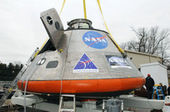
© UCLA/ETCDigital recreation shows what Karnak probably looked like in ancient times.
For the past two years, a team of UCLA Egyptologists, digital modelers, web designers, staff and students has been building a three-dimensional virtual-reality model of the ancient Egyptian religious site known as Karnak, one of the largest temple complexes ever constructed.
The result is Digital Karnak, a high-tech model that runs in real time and allows users to navigate 2,000 years of history at the popular ancient Egyptian tourist site near modern-day Luxor, where generations of pharaohs constructed temples, chapels, obelisks, sphinxes, shrines and other sacred structures beginning in the 20th century B.C.
Developed by UCLA's Experiential Technologies Center - which has helped pioneer the digital reconstruction of historical sites, including the innovative Rome Reborn, released in 2006 - the Karnak model and a host of additional digital resources are now available for educators, students, scholars and the public to explore for free
HERE.



